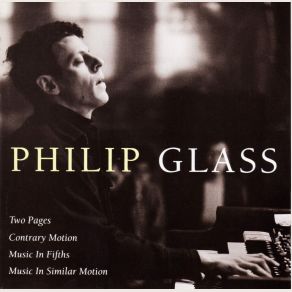Glass: Two Pages, Contrary Motion, Music In Fifths, Music In Similar Motion
Download links and information about Glass: Two Pages, Contrary Motion, Music In Fifths, Music In Similar Motion by Philip Glass. This album was released in 1994 and it belongs to genres. It contains 4 tracks with total duration of 01:14:09 minutes.

|
|
|---|---|
| Artist: | Philip Glass |
| Release date: | 1994 |
| Genre: | |
| Tracks: | 4 |
| Duration: | 01:14:09 |
| Buy it NOW at: | |
| Buy on iTunes $9.99 | |
Tracks
[Edit]| No. | Title | Length |
|---|---|---|
| 1. | Glass: Two Pages | 18:00 |
| 2. | Glass: Contrary Motion | 15:35 |
| 3. | Glass: Music In Fifths | 23:23 |
| 4. | Glass: Music In Similar Motion | 17:11 |
Details
[Edit]Two Pages' liner booklet includes a fine photograph: the 1971 riverside debut of Glass' group, presented as low rent, public permit spectacle. The Philip Glass Ensemble sit in concentration over their instruments, with the Brooklyn Bridge lights appearing next to them. Mop-haired Glass wears jeans and denim jacket while leaning into his electric organ, the lights of Manhattan in view across the water behind him. By the '90s, he made an estimable public success of his opera and movie scores, rarely presenting electric music. But he didn't forget his roots as a bandleader. In 1987, the Ensemble recorded the second half of Music in Twelve Parts, then released them with the previously recorded six segments in a three-CD set on Virgin America. In 1994, longtime Glass associates engineer Kurt Munckasi and Ensemble keyboardist Michael Riesman did the same for these four early works, originally released on small labels in the early '70s. Excepting Glass' collaborations with filmmaker Godfrey Reggio, all of the operas and soundtrack encountered have been uneven — too much the regular opera, too obvious the movie score. In contrast, these four harmonic strings spoofed the music world's conventional wisdom — in fact, "Music in Fifths" sets note against note as a violation of first-species counterpoint. Glass found other ways to twit his mentors. Not only were the harmonies skewed, not only were the keyboards electric, but the composer recharged his counterpoint using Indian concepts of time. The razor-sharp woodwind and keyboard sound of the last two cuts are terrific — those who prefer electric Glass enjoy their speed and brightness of these compositions, which might even intrigue fans of Glass' symphonic work. The organ and synthesizers add steel to his sound, as well as a certain creative tension: the guy's ambitions are banked by the limits of his Ensemble's keyboards and woodwinds, but they never falter in pushing to become bigger. That's the story behind the picture.